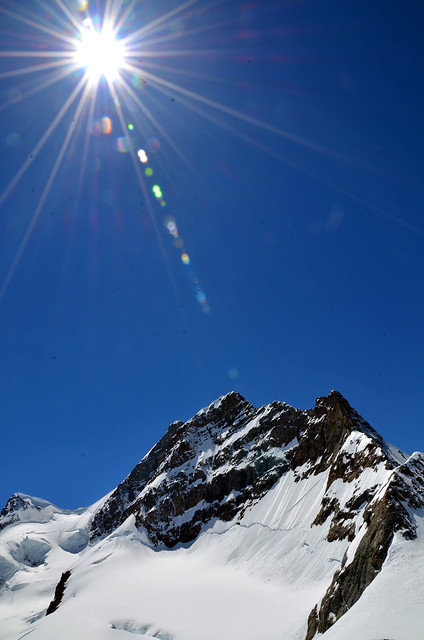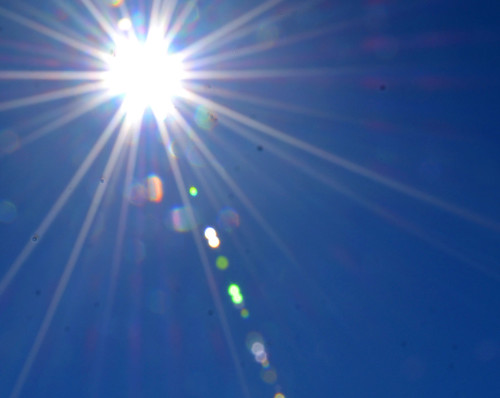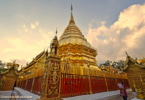Check Sensor Dust and Clean Your DSLR Dirty Image Sensor Before Traveling
One of the most overlooked but critical issue of our DSLR is a dirty image sensor. We tend to neglect the effect of a dirty sensor or, like me, always thought that image sensor will not get dirty easily if I change lenses carefully and set my camera’s internal sensor cleaning function to work frequently. I thought a dirty sensor would definitely be the last problem to face since I didn’t get any problem with my old Nikon D60 after 2 years of shooting. I was wrong! I got a seriously dirty image sensor of my Nikon D7000 after just one month of shooting!
Look at this photo below that I shot towards sunlight with small f20 Aperture:
Can you see those tiny dark spots in the sky? This is the evidence of a dirty DSLR’s sensor. What is a dirty image sensor of a DSLR? Image sensor is a light sensitive panel device in all Digital cameras that acts like the retina tissue lining in our eye balls. It transforms analog light signal to digital data that will then be calculated and reproduced images. When any dust, pollens, or any object falls and sticks on the low pass IR filter in front of the image sensor ( a dirty sensor actually refers to a dirty Low Pass Filter in front of the sensor), tiny dark spots will appear in your photos, and you have just got a dirty image sensor! However, it is only apparent when you shoot photos with smaller Aperture, such as f20, as deeper Depth-Of-Field will reveal clearly any dirt on the sensor. The above photo show you how dirty is my D7000’s image sensor! Take a closer look at those tiny dark spots that spread all over the place!
I zoomed into the same photo to let you see more clearly on those dust or pollen accumulated on the sensor. I did not realize this until I shot some sunburst photos on top of Jungfrau mountain of Switzerland, when I stopped down my camera’s Aperture to f20. I really got a shock! Oh My God! What had happened to my D7000? Did my DSLR’s sensor expose too long to direct sunlight? Have sun beams just damaged my camera’s sensor? Are they dirt? How could my D7000’s sensor be so dirty after only few months of shooting while I did not have this problem with my old D60 after 2 years? Are they condensation under freezing temperature? Are they permanent? There were too many questions circulating in my mind.
Dirt accumulation does not depends on your camera’s age. It depends merely on how you handle your camera and how you change your lenses. Changing lense more frequent means higher chance of dust sneaking into your camera’s body. I normally changed lenses very carefully. I always face my camera downward when changing lenses and I’ve been doing this since my D60. There haven’t got any dust on my D60’s sensor, why my D7000 had more than a dozen of them? I think I know why.But sadly only after my Europe trip… 🙁
Ever since DSLR manufacturers incorporated Live View and video recording function into their latest DSLR, they have also deliberately introduced a second gateway for the dust! Whenever you shoot still photos or video in Live View mode, your DSLR will keep the mirror flipped and locked up to let lights go into image sensor for as long as you wish to. This process has also opened the gate of a camera’s body access for other unwanted objects, such as dust, dirt, pollen or hair to sneak into the heart of a camera, which is the image sensor device! It will get even worse when you shoot with a long zoom lens. When you pull your lens or zoom out, you have, at the same time, pumped external air into your camera! If you shoot in Live View, you are actually pumping air directly onto the image sensor! This was why my Nikon D7000’s sensor was so dirty after only a few months of shooting while my old Nikon D60 hadn’t got this issue even after more then 2 years of shooting!!
So now you know that having a dirty image sensor is very easy nowadays, especially when you use zoom lens and always shoot in Live View mode. The lucky thing is that we can still take photos with a dirty sensor, as long as we set the Aperture no smaller than f3.5, or keep shooting in wide open Aperture. However, the unlucky thing is that we would not know our sensor is dirty until we shoot in small Aperture, for me, for day and night landscape shots, or sunburst shots, and it would be too late to know by then! We can not do any thing about it on site or on travel, unless we wish to risk ourselves for damaging the delicate image sensor by cleaning it ourselves in dusty outdoor environment! REMEMBER: Nikon has put a disclaimer clause in most of their DSLR’s User Manual that cleaning of the image sensor should be done by Nikon Service Centre. In Malaysia, cleaning a DSLR’s image sensor by Nikon Service Centre is fast and relatively cheap. It can usually be done in 15 minutes for a cost of RM20.00 if your camera is still under warranty and RM60.00 if it is not. You should check your local Nikon Service Centre for actual cost and time needed.
Conclusion? Make sure you check your DSLR’s image sensor a couple of weeks before each photography travel for its cleanliness. You can do this by shooting bright sky or well lit plain colour wall with small f22 Aperture. Any dirt or particles stuck on the sensor could be revealed clearly in the photo. You will still have enough time to send in your camera for cleaning by specialists. The cost and time for cloning out those dark spots in your images in post processing is definitely much much more than that of cleaning the image sensor before each travel! I have it very well experienced recently with my D7000 on my Europe Travel MkII, which had even spoilt my photo taking mood! ![]() – Travel Feeder, your ultimate photo travel blog
– Travel Feeder, your ultimate photo travel blog






It’s about time I invest in a DSLR. Been using my iPhone for photography.
- June 24, 2011